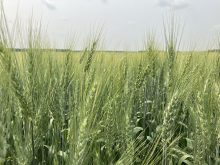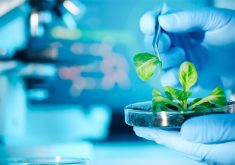Researchers have known for decades that plants can sense carbon dioxide concentrations that trigger pores in their leaves to open or close and control water evaporation. Plants can lose more than 90 percent of their water this way.
But identifying the sensor that regulates how plants open and close their pores and understanding how it works has been elusive.
Now, scientists at the University of California, San Diego, have achieved a breakthrough in locating the sensor in arabidopsis laboratory plants.
“Our research has been focusing on the basic mechanisms by which elevated carbon dioxide reduces transpiration from plants,” said Julian Schroeder, professor in the university’s School of Biological Sciences.
Read Also

Huge Black Sea flax crop to provide stiff competition
Russia and Kazakhstan harvested huge flax crops and will be providing stiff competition in China and the EU.
“This is a natural response. We’ve been working on this pathway for some time and discovering many of the mechanisms as to how it works. But the primary carbon dioxide sensor was still unknown. It was the Holy Grail of our fundamental research.”
He said that, if you take the biomass of a plant, the element that is most abundant is carbon, which is absorbed from the atmosphere via photosynthesis.
For photosynthesis to have access to the carbon, the CO2 has to flow into the inside of leaves, and it does this through the tiny pores in plant tissue called stomata.
“For every carbon molecule fixed by photosynthesis, the plant can lose from 200 to over 500 water molecules,” said Schroeder.
“Carbon dioxide diffuses into the leaves through the open pores and, when it does that, the plant evaporates water. You could say that the intake of carbon is not very water use efficient for the plant but, at the same time, when you elevate carbon dioxide inside the leaf, there are sensors that narrow the stomata aperture, or opening.”
With the current conditions brought on by climate change, there are higher carbon dioxide concentrations in the atmosphere now than in pre-industrial times and these concentrations are growing. The CO2 increases cause the stomata to close, reducing transpirational water loss.
Conversely, with lower CO2, the stomata open, and water loss is increased. The sensor’s response to fluctuating CO2 is critical since it dictates how much water a plant or a crop loses.
“Some plants are able to narrow their pores and take in the same amount of carbon, but lose less water,” he said. “But many of our agriculturally bred crops are not optimizing this. Instead, we’ve optimized them for maximum yield.”
Using a variety of research approaches, the breakthrough came when the researchers realized that two proteins were working together.
“The proteins were known to us,” said Schroeder. “We knew that they played an important role in the CO2 response but what we didn’t realize was that, together, they formed the sensor. Previously, we looked at one protein but couldn’t find that it had the sensor response to the CO2 and then we looked at the other protein and couldn’t find it there either.”
The proteins were identified:
- a high leaf temperature 1 protein kinase known as HT1
- specific members of a protein kinase family or MAP kinase enzyme known as MPK 4 and MPK 12.
“Our findings reveal that plants sense changes in CO2 concentration by the reversible interaction of the two proteins to regulate stomatal movements,” said Yohei Takahashi, who was the first author of the paper and is now based at the Institute of Transformative Bio-Molecules at Nagoya University in Japan.
“This could provide us with a new plant engineering and chemical target toward efficient plant water use and CO2 uptake from the atmosphere.”
The research team created a model of the intricate structure of the sensor. The model pointed to areas where genetic mutations have been known to restrict the ability of plants to regulate transpiration in response to CO2. The mutants appear to cluster where the two sensor proteins come together.
Schroeder said there is a lot of emphasis on plants growing where there are insufficient amounts of water and the focus would be to improve their water-use efficiency.
“If you have a crop that has a lazy CO2 response such as soybeans, we can improve their water-use efficiency by selection and breeding, or through genetic engineering,” he said.
The farming community has shown interest in the research but Schroeder cautions that their studies are still at the basic level.
The research report was published in the journal Science Advances.

















